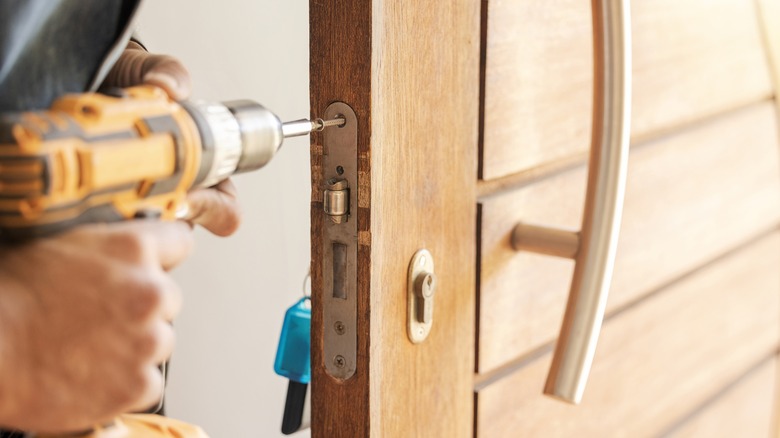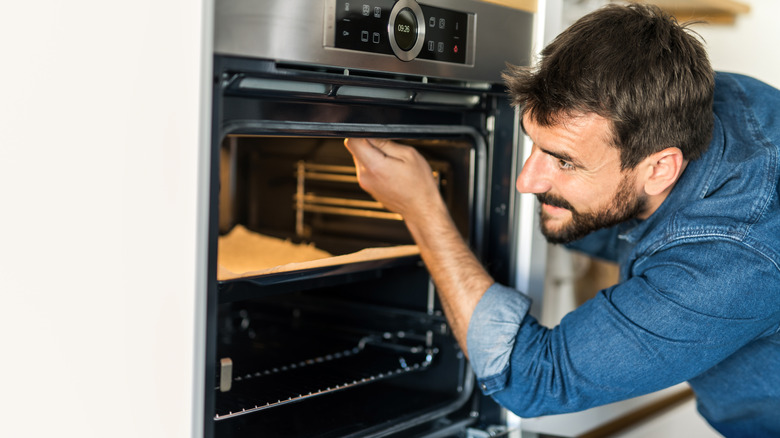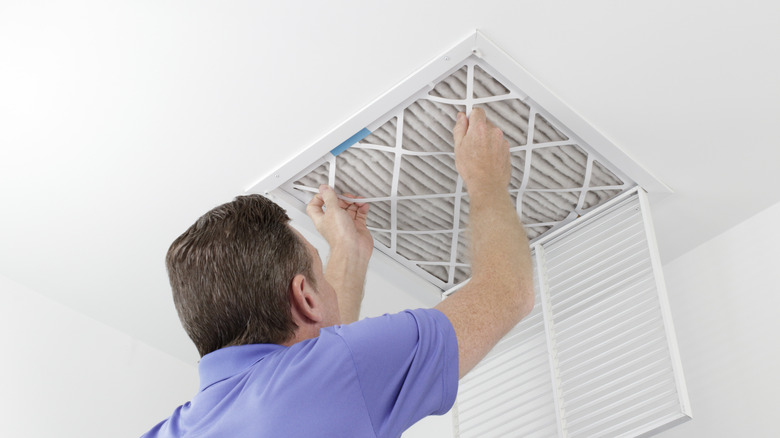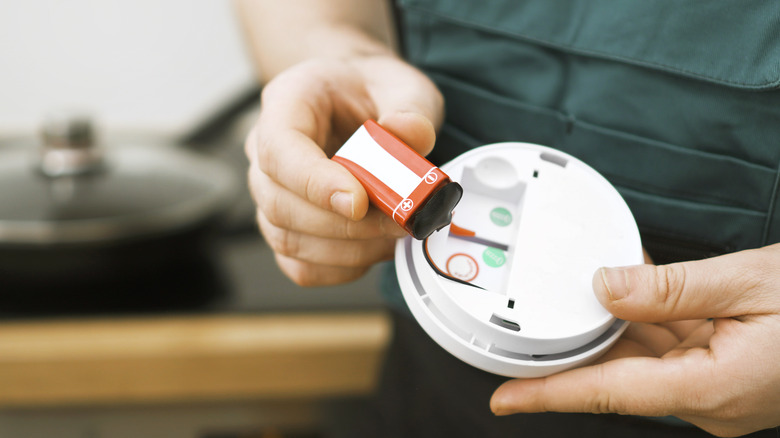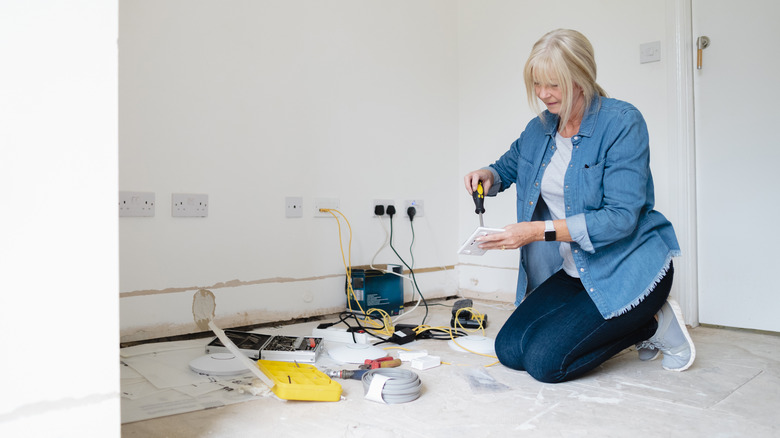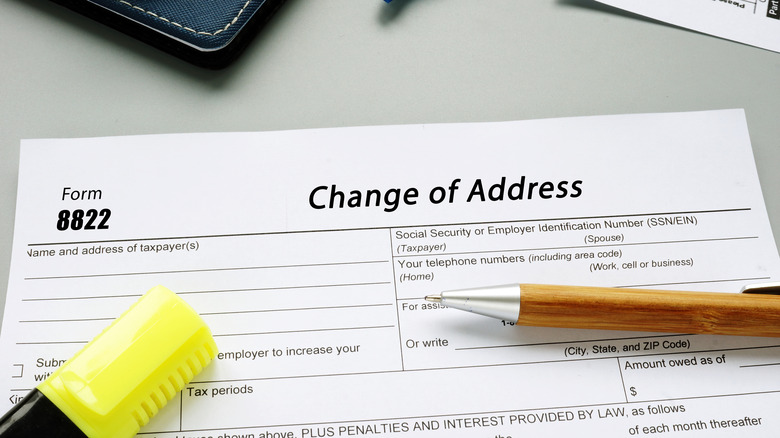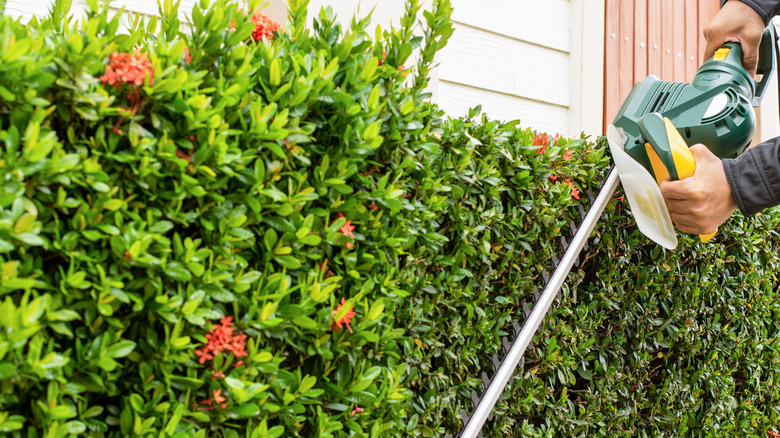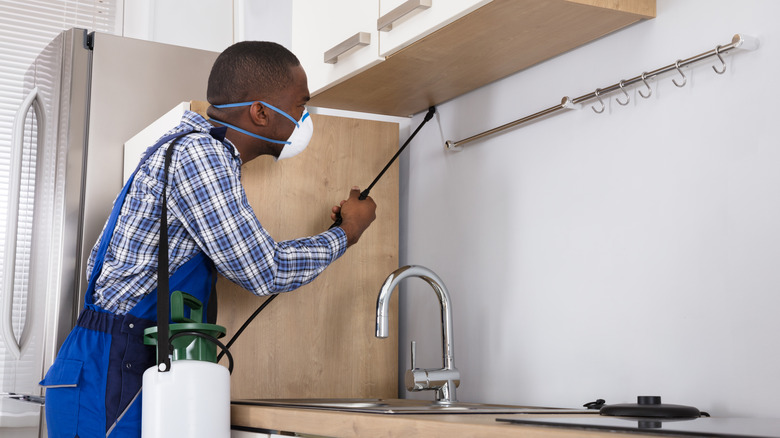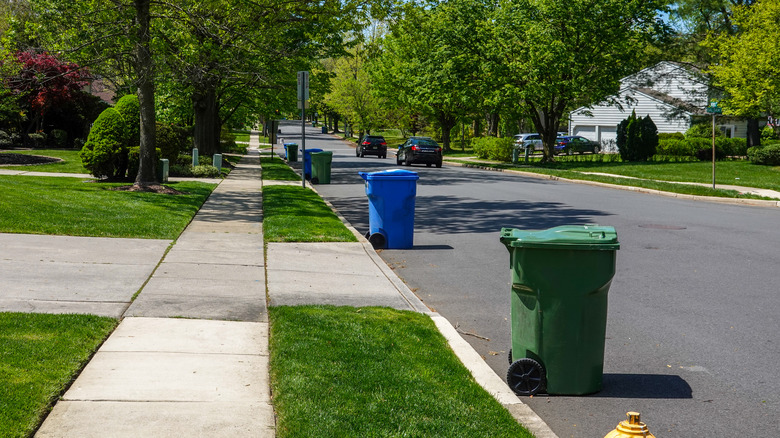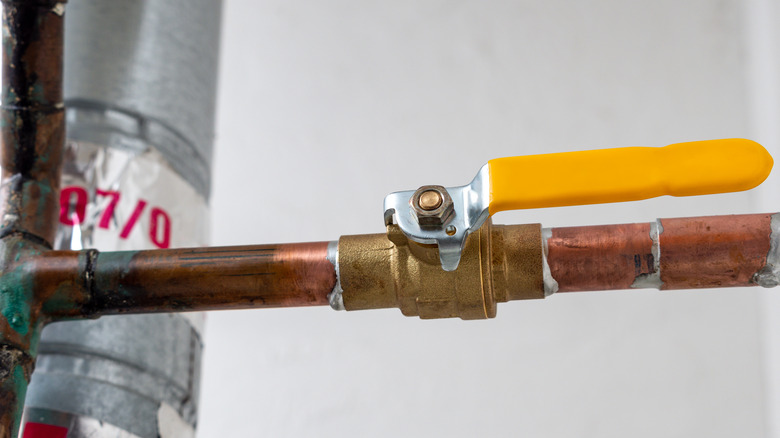Important Things To Do Right Away When Moving Into A New Home
Buying a new home is a thrilling journey, marked by the promise of fresh beginnings and endless possibilities. Amidst the excitement of selecting paint colors and arranging furniture, it's crucial not to overlook the less glamorous side of homeownership, which is maintenance. While the allure of designing your dream home may take center stage, dedicating time to essential upkeep activities can yield invaluable peace of mind in the long run.
Prioritizing maintenance might not be as thrilling as selecting that perfect reading nook or envisioning a blooming garden, but it's the practical foundation upon which your dreams can flourish. Every house has its unique quirks and requirements, so as you embark on this adventure, tailor these chores to the specific needs of your dwelling. You'll be glad you set aside time to complete these tasks early, giving you more space and freedom to nurture the rest of your abode. Let's take a look at some important tasks to do as you move into your new home.
Change the locks
As you step into your new home, the thrill of starting fresh is undeniable. Before you worry more about how to arrange your furniture and decorate rooms, focus on keeping your space safe by replacing the locks. Security is paramount, and for good reason. The exterior locks of your home might have passed through numerous hands before yours, making it wise to eliminate any uncertainty by replacing or rekeying them. After all, who knows who might still possess copies of the existing keys?
Considering the digital age we live in, bolstering your security isn't just limited to physical locks. If your new dwelling comes with the added perk of a home security system, it's imperative to confirm that it's fully operational and tailored to your needs. If your house doesn't yet have a security system in place, now might be the ideal time to contemplate installing one. With an array of options available, from smart cameras to motion detectors, you can weave an intricate web of protection that ensures both your physical and mental ease.
Do a deep clean
Before the whirlwind of moving boxes and arranging your belongings takes over, invest time in completing a thorough, deep clean of the entire house. This sounds like a chore, but it's an essential prelude that will make your space feel even more like your own. From floors to ceilings, windows to appliances, each corner deserves your attention. Why bother doing this so early into the move? Beyond the obvious benefits of hygiene and aesthetics, a clean start sets the tone for your future within those walls, marking the beginning of your journey with a pristine slate. The idea might be daunting, especially when faced with the prospect of scrubbing unfamiliar surfaces, but here are some tactics to streamline the process.
First and foremost, divide and conquer. Break down the cleaning into manageable chunks, focusing on one room or area at a time. Clear the space before diving in; cleaning empty surfaces is much easier. And if time or energy is in short supply, consider enlisting help from friends, family, or even professional cleaners. The gratification of stepping into a spotless home, where every corner sparkles, is worth the initial effort. Plus, cleaning before your furniture and decor are unpacked grants you unrestricted access, making navigating tight spaces easier and ensuring even the nooks and crannies receive their fair share of attention.
Inspect appliances
It's fine to start getting comfortable in your new household, but take a moment to put on your inspector's hat and give all the appliances that came with the house a test run. Fire up the stove and oven, turn on the dishwasher, peek into the refrigerator, and don't forget the washer and dryer. Although you may have had an inspector run through the home, they don't all check appliances. That's why it's a good idea for you to do what is known as a PAT test (Portable Appliance Test). This simply means that you'll inspect wires and the features of each appliance, testing them manually. If you're uncomfortable doing this yourself, look into hiring an electrician.
While testing is a great start, a little extra care can go a long way. Some additional things you can do for ease of mind include cleaning the dishwasher filter. You may also want to change the washing machine hoses, regardless of how new and clean they appear. If you encounter any unexpected glitches, remember that communication is key. If appliances were listed as part of your buying contract and are not working as expected, you can reach out to your legal team for advice. It's all about ensuring that the promises made during the purchasing process translate into the functional reality of your new home.
Familiarize yourself with the circuit breaker
A task that might not spark immediate joy but can save you heaps of time and frustration down the road is locating and labeling the circuit breaker switches. If you have a sudden power outage, don't fumble around in the dark, uncertain which switch corresponds to which room. Getting familiar with your circuit breaker is another way to ensure there are no issues with it, as major problems such as loose wiring can cause electrical fires and other potential hazards. That's where the magic of labeling comes in. While it might seem like a mundane chore, doing this sooner rather than later is a game-changer.
To start, turn off one switch and have someone in various rooms help you identify which lights or outlets are affected. This process can help you map out which circuit controls each area. As you go, jot down simple labels that make sense to you. For instance, "Living Room Outlets," "Master Bedroom Lights," or "Kitchen Appliances." If you're feeling particularly organized, you can even color-code the labels for quick identification. This chore offers a different kind of fulfillment when moving into a new home. It reassures you that your house is designed for convenience, safety, and ease.
Change HVAC filters
An often overlooked task that deserves your attention within moments of moving into your new home is to change your HVAC filters. These ensure that the air circulating through your house is clean and comfortable. If your new abode comes equipped with heating, ventilation, and air conditioning, giving those filters a little TLC is a smart move. HVAC filters collect dust, allergens, and other particles over time. Neglecting them can reduce system efficiency, raise energy bills, and compromise air quality. When you take the time to replace or clean them, you're maintaining optimal airflow, plus eliminating potential irritants from being blown around.
First, locate the filters, which are often near the return air vent or inside the HVAC unit itself. If they're disposable, note the filter size and type (usually printed on the filter frame) before heading to the store. If they're washable, use warm water and a few drops of dish or hand soap, and scrub the dirt and grime with a soft-bristled brush. Follow these steps up with another rinse under the water and let it air dry completely before putting it back on. Whether you do this yourself or call in a professional, the result is the same: a healthier, more comfortable living environment that aligns with your new chapter's aspirations.
Check safety devices
Safety should be a critical concern when moving into a new home, so you should ensure that smoke and carbon monoxide detectors are not only present but also operating effectively. These sentinels are your early warning system, ready to rouse you from sleep or alert you while you're going about your day-to-day activities. Dedicating a few minutes to test and replace batteries in these detectors is a worthy investment since you never know when they were last changed.
Testing your detectors is a straightforward process. Press the test button on each unit and listen for the unmistakable beep that signals their functionality. If you don't hear anything, it's time to replace the batteries. Changing them at least once a year is generally recommended, though you should check their function at least twice a year. A clever strategy to remember this is to align it with a specific event, like Daylight Saving Time. Whenever you turn your clocks forward or back, refresh the batteries in your detectors. This simple habit can save you from the frantic beeping of low-battery alerts in the wee hours of the night.
Inspect plumbing and electrical
Stepping into your new abode is a prime opportunity to play detective and seek out any potential water-related mysteries. Take a stroll around sinks, toilets, and faucets, examining every nook and cranny for telltale signs of leaks, drips, or water damage. Your vigilant eye can preempt any plumbing surprises that might otherwise sneak up on you. Don't forget to check water pressure and drainage to ensure showers and sinks are speedy. Addressing these matters right away helps to keep your new home watertight. But the inspection doesn't stop with water. Your electrical setup deserves a nod, too.
Structure Tech recommends checking overhead wires, outlets, cover plates, extension cords, and general wiring. Get yourself a voltage tester and check every outlet to ensure they're all in working order. If you stumble upon any uncooperative or malfunctioning outlets, you can replace a faulty one easily. First, turn off the circuit, unscrew the old outlet, wire the new one, and you're done. If tinkering with wires isn't your cup of tea, reaching out to a professional electrician can zap away the inconvenience. And if something proves to be far worse than the inspection or even the appraiser discovered, get on the phone with your legal team to discuss your options.
Change your address and utilities
An administrative task that can sometimes fall through the cracks when moving is the act of changing your address and utility information. Having to deal with all that paperwork can be frustrating, but simply notifying your utility companies about your change of address ensures that the lights stay on, the water flows, and the internet remains connected. To navigate this administrative chore, start by creating a checklist. Jot down a lineup of all the utilities you'll need to update. This can include water, gas, electricity, internet, cable, and any others that apply.
Then, embark on a journey of notifications by informing the post office about your new address. You can find an online form on their website that makes this step even easier. Next, reach out to your utility providers and set up your new accounts. This is also a great moment to assess whether you'd like to explore different plans or providers for your new location. Don't forget to sync up your billing cycles to avoid any overlap or gaps in services. This logistical endeavor sounds ominous and time-consuming, but if you dedicate one day to knocking all of it out together, you're setting the scene for a seamless transition.
Trim landscaping
If you're a new homeowner, you might find yourself wearing a gardening hat sooner than you'd expect. Caring for a yard in addition to a house brings extra attention to detail and diligence. That's why you should take a stroll around your property and observe the bushes, trees, and shrubs that call it home. The greenery that adds charm to your landscape can also inch its way too close to the abode, potentially causing harm. Checking that they don't encroach on windows or pathways is crucial. This is especially pertinent if your inspection has unearthed hints of water damage on your exterior. Trimming back these plants not only prevents them from blocking sunlight but also curtails any potential for further water damage.
Start by trimming any branches that touch your house, as they can create entry points for pests or trap moisture against the structure. Next, ensure your plants are at least a foot away from your home's exterior to allow proper air circulation. When you're done, stand back and admire your well-tailored landscape, where each plant finds its place without overpowering the scene.
Inspect for pests
Moving into a new house requires a great deal of detective work, and another thing you should do before arranging furniture and decor is to inspect for unwanted pests. Wander through your living spaces, checking nooks and crannies for any unwelcome signs. According to Lawn Starter, the main things you want to look out for are droppings, nesting, and scratch or gnaw marks. While it might not be the most delightful task, it's one that can save you from potential headaches down the road. Addressing pest issues quickly prevents them from evolving into full-blown infestations that can damage both your home's structure and your peace of mind.
If your detective work uncovers any hints of these sneaky bugs, take an afternoon to seal up any holes or entry points where they might be entering. That could mean re-caulking window and door frames, patching screen holes, or replacing wooden floorboards with giant gaps or small holes. Once that's done, consider calling a professional pest control service. These experts can identify the source of the issue and implement effective strategies to rid your home of them for good. Remember, while a DIY approach might seem tempting, it often falls short of truly eradicating the problem at its root. So, don't hesitate to seek professional assistance if needed. This investment keeps your new home free from creepy crawlies that might otherwise dampen your spirits and comfort.
Learn the waste and recycling schedule
If you've moved to another state or district, navigating the location comes with a whole array of discoveries, and one of the practical details to uncover is the trash and recycling pickup schedule. As you unpack your life into your new home and come face-to-face with a mountain of cardboard boxes from the move, knowing when to bid them farewell is crucial. While this might not be the first task on your to-do list, it's certainly one that can prevent last-minute scrambles and ensure your home remains clutter-free.
Reach out to your local waste management or recycling center early on. They can provide you with a pickup schedule and guidelines for what materials can be recycled or thrown out. Many areas also offer online resources that make finding your specific collection days easy. And while you're at it, take a moment to familiarize yourself with any local rules or regulations unique to your new area. Small steps like learning the ins and outs of trash and recycling schedules can significantly affect how smoothly your new life unfolds.
Locate the main water shut-off value
Lastly, there is a small but essential detail that deserves your attention: the location of the main water shut-off valve. This little piece of equipment wields significant power, and having this knowledge at your fingertips is beneficial for the longevity of your home. You don't need to dash to find it the instant you cross your new threshold, but it's recommended that you tackle it after unpacking and settling in a bit, as it does help create an extra layer of safety. That's because it's necessary to turn off when you discover a burst pipe or if your toilet or sink springs an unexpected leak. The valve is usually located near where the main water line enters your home, often in the basement or crawlspace, though yours may be outside if you live in a warmer area.
Once you've identified it, don't hesitate to give it a little exercise by turning it on and off a couple of times so you're familiar with its function. Make sure everyone in your household knows where it is, too, because plumbing emergencies don't always happen when you're the one closest to the valve. Consider labeling it with a tie tag or an adhesive that can withstand fluctuating temperatures and humidity, like duct tape. When you put this task on your post-move to-do list, you're giving yourself a valuable tool to tackle the unexpected.

